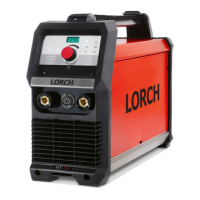LORCH
15 Welding basics
15.1
St
ick
electrode
wel
din
g
<--
-
----
Coated
st
ick electrodes are used for the widely-u
se
d
manual metal arc welding process (stick electrode
weld-
ing). The coating
of
the electrode melts off during the
weldi
ng
process together wi
th
the co
re
wire. T
he
coating
gene
ra
tes the shielding gas. Additionally the burning-
off coating compensates alloy elements. which are de-
stroyed
in
the molten pool. A slag layer forms on top
of
the welding seam. which covers and protects the cooling
welding se
am
against the a
ir
.
The coatings
of
the electrodes differ according to thick-
ness and type,
i.
e. chemical composition. This
re
sults
in
different welding properties and con
seq
uently different
applications for t
he
e'lectrodes. Types a
nd
nomenclature
a
re
defined in DIN EN 499 (forme
rl
y 1913).
-'---
Stick electrode
Base
me
ta
l
15.2
TIG
weld
ing
The
TI
G welding process is a universally-applicable pro-
cess which creates high quality joint
s.
T
he
electrode
of
t
he
TIG p
ro
cess consists
of
non-melting
tungsten, t
he
shielding gas is an inert g
as
. In English
usage we
sp
eak
ofTIG
welding ("Tungsten" = Wolfram
).
Inert gas is chemically neut
ra
l and does not react with
the weld meta
l.
Inert gases are, e.g. arg
on
, helium and
their mixtures.
Usually pure argon (99.9%) is used. The
welding g
as
must be d
ry
. DIN 32 526 defines the differ-
ent types of shielding gas.
TI
G wel
ding
process basics
A non-melting tungsten electrode is clamped with a col-
let into a
gas
or water-cooled torch. The arc burns be-
tween the tungsten electrode and the workpiece in an
in
e
rt
shielding gas atmosphere. T
hu
s the tungsten elec-
trode acts as an arc carrier. The arc melts the workpiece
point by point and forms the weld pool. The shieldi
ng
gas
escapes through the gas nozzle. This gas protects the
tungsten electrode, the arc and t
he
molten pool against
t
he
su
rrounding air. This prevents undesired oxida
ti
on.
Con
seq
uently,
po
or welding results may occur due to
tro
ub
le with the shielding gas supply.
In case additional filler material is required. filler
~1\re
is supplied either manually, as
in
gas name
we
ldin
g,
or
-18
-
We
lding
bas
ic
s
automatically
by
means of a cold wi
re
feeder. The filler
wire must be equally or mo
re
highly alloyed than the
base mater
ia
l.
Fla
nge and corner welds can be crea
te
d
easily without filler wire.
Sh
ieldi
ng
gas
B
as
ically, both DC and AC may be used for TIG welding.
The current mode and pol
ar
ity depend on the material to
be welde
d.
No
n or low-alloyed steel, high-alloyed steel and copper,
as
well as titan
iu
m a
nd
tantalum are welded with
DC
.
The electrode is connected at the minus pole because of
the stronger
cu
rrent loading.
When welding aluminium and nnagnesium as well
as
their a
ll
oys,
AC
must be used in order to tear up the high-
melti
ng
and tough oxide skin which forms on the molten
pool or which is present on the base
metal. If t
he
oxide
skin is missin
g.
e.g. there has been w
el
ding on the same
part for a longer tim
e,
the arc can
be
un
sta
ble or break
up from time to
ti
m
e.
Shape of the electrode
tip
Tungsten electrodes always have to be ground length-
wi
se
because crosswise g
ri
nd
ing marks cause an un-
steady arc.
10
.13

